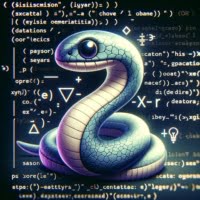14 Aug 2023
String Slicing in Python: Usage and Examples
Have you ever found yourself stuck in a maze of string manipulation? Fear not! Python, renowned for its simplicity and readability, offers an elegant solution – string slicing. This article aims to guide you through Python’s string slicing, a tool that can revolutionize your approach to string manipulation. Whether you’re a seasoned developer or a ...
14 Aug 2023
Python Integer Division: How To Use the // Floor Operator

Python, a powerful and flexible language, is a mainstay in many fields, from web development to data processing. To truly tap into its potential, it’s crucial to understand its basic mathematical operations, including division. In this blog post, we’re setting out on a deep dive into Python’s division operations. We’ll explore the different ways to ...
14 Aug 2023
Get Length of Array in Python: Guide and Examples

Imagine a train, with each carriage representing an element. In Python programming, this train is what we call an array. The length of the train, or the number of carriages, is analogous to the length of an array – the number of elements it contains. In this guide, we’ll walk you through different methods to ...
14 Aug 2023
XOR in Python: Usage Guide to Bitwise XOR

XOR, standing for ‘exclusive or’, is a type of bitwise operation that’s a potent tool in the Python toolbox. It can open up a whole new realm of coding opportunities. XOR operations are a fundamental part of Python programming. They’re utilized in a wide array of applications, from data manipulation to error detection and cryptography, ...
14 Aug 2023
Python Max() Function Guide: Uses and Examples

Python, a language known for its simple syntax and rich library of built-in functions, offers a range of powerful tools for both beginner and seasoned developers. Among these, the max() function stands out for its robustness and versatility. This built-in function is often used in daily programming tasks due to its ability to return the ...
13 Aug 2023
Python Exponents | How to Raise a Number to a Power

Exponentiation is a fundamental operation in many areas of programming, from data analysis to algorithm design. However, it can be a stumbling block for many coders. Python, renowned for its readability and ease of use, offers not one, but five powerful techniques to calculate exponents. This blog post aims to simplify these methods, empowering you ...
13 Aug 2023
Using Python Heapq Module for Heaps and Priority Queues

Welcome to the fascinating world of Python’s heapq module. This powerful tool is not just a simple module; it’s a versatile asset that introduces the concepts of priority queues and heaps into your Python programs. Priority queues and heaps might seem like complex concepts, but consider this. Imagine you have a to-do list. You could ...
13 Aug 2023
Python Min() Function Guide: Uses and Examples

Welcome to our in-depth exploration of Python’s min() function, a hidden gem in the treasure trove of Python’s built-in functions. The min() function is not merely a tool for finding the smallest number in a list. It’s a symbol of Python’s unique handling of integers, a feature that distinguishes it from many other programming languages. ...
13 Aug 2023
Python Copy File Guide: 8 Ways To Copy a File in Python

Ever wondered about the secret powers of Python’s built-in modules? Buckle up! We’re about to dive into the fascinating world of copying files in Python. Python, with its powerful and versatile nature, is packed with a rich library of modules that simplify our coding lives. Among these, the os, subprocess, and shutil modules shine, providing ...
13 Aug 2023
Python Delete File | How To Remove File or Folder in Python

Ever felt overwhelmed by a clutter of files and directories in your Python project, unsure of how to efficiently delete them? You’re not alone. Managing files and directories is a routine task in Python, which can often seem intimidating. But there’s good news! Python comes loaded with a rich library of pre-built modules, such as ...